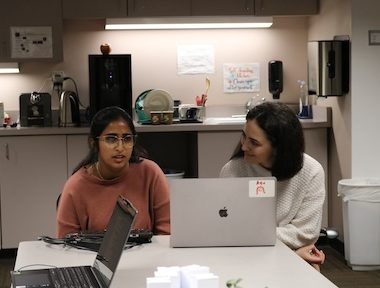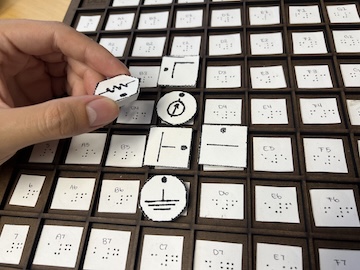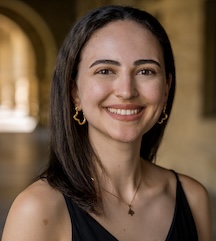Expanding Access in Electrical and Computer Engineering: Lessons from a Blind Student’s Autoethnography
By Aya Mouallem, Trisha Kulkarni, and Dr. Sheri D. Sheppard
Understanding the Problem
The 2023 National Center for Science and Engineering Statistics (NCSES) report Diversity and STEM: Women, Minorities, and Persons with Disabilities, data on postsecondary degrees earned by persons with disabilities are very limited in comparison to other minority groups [1]. The report states that 65% of STEM employees with a disability had not attained a bachelor’s degree. Among doctorate recipients with disabilities in 2021, individuals in engineering had the lowest rate of disability among all majors of study, at 8.2%. As the report highlights that 24% of the U.S. workforce is employed in STEM occupations, it remains imperative to address the consistently low numbers of students with disabilities pursuing engineering degrees in higher education.
There have been recent commendable research works exploring the experiences of engineering students with disabilities and addressing the former by proposing new tools, designing educator resources, and informing policy decisions. However, such efforts remain dispersed and relatively few. Thus, it is important that we conduct a systemic investigation of the inaccessible resources and training available in engineering education. Our paper, “Leveraging the CARE Methodology to Enhance Pedagogical and Institutional Support for Blind or Low-Vision (BLV) Learners in Electrical and Computer Engineering (ECE),” which received the 2024 ASEE Best Diversity, Equity, and Inclusion Paper Award, presents a comparative analysis of blind and sighted experiences in the introductory electrical engineering class at our university, identifying inequitable barriers that blind learners face in such environments and proposing systemic strategies to overcome such challenges.
Our Team

Co-authors Aya Mouallem (right) and Trisha Kulkarni (left) lead the discussion during a co-design reflection session as part of a community engagement program that they hosted for blind and low-vision participants at Stanford University.
Our research team for this work brought forward a breadth of lived experiences and relevant areas of expertise, and we share these diverse backgrounds in the following positionality statement. Kulkarni is currently a master’s degree candidate in Computer Science at Stanford University. She was the first blind student to complete the introductory engineering course as an undergraduate requirement. She completely lost her vision during her early teens, which necessitated her use of nonvisual techniques during her education, including Braille and digital screen readers. Kulkarni explored her experiences in the introductory engineering course via autoethnography in this work.
Mouallem is a sighted researcher and fourth-year PhD candidate in Electrical Engineering at Stanford University and focuses on designing new technology-based tools and frameworks to improve the accessibility of ECE education to BLV learners. Mouallem has collaborated with BLV community members and organizations throughout her research projects, and she has mentored blind undergraduates in engineering research at Stanford. She has prior experience teaching the electrical engineering course under study. Sheppard is an experienced mechanical engineering educator. Adapting her hands-on class exercises and project-based learning activities for her students with disabilities, including BLV students, has been challenging, and not always successful, so she committed through her teaching and research to explore how we can make engineering education both exciting and accessible.
Exploring Blind and Sighted Student Experiences in the Introductory Electrical Engineering Course
To study Kulkarni’s experiences as the first blind student who completed the introductory electrical engineering course, we adopted the autoethnography method retrospectively and collected 7,239 words in the form of written journal entries and transcribed discussion notes over six months. In earlier work [2], we collected weekly and final surveys, seeking close-ended and open-ended answers to explore the experiences of 42 sighted students who were enrolled in the same electrical engineering course. To analyze the collected data in each case, we relied on the Challenging and Rewarding Experiences (CARE) assessment methodology, which we had developed in prior work [2]. This methodology posits that the intersecting areas of the most Challenging and Rewarding Experiences, or CARE areas, are the most important areas to improve in order to better align what the students value and take away from the course with the educator-planned course objectives. In particular, the CARE methodology categorization sheds light on students’ “unproductive” struggles and “healthy” challenges, in addition to what they find fulfilling and rewarding in their learning experiences.
Areas of Inequity

Tactile resources developed by the Designing Education Lab at Stanford University to improve the accessibility of electronic circuit design activities to learners who are blind or have low vision.
While we noticed an overlap in the CARE areas identified for blind and sighted students, most challenges that Kulkarni faced were rooted in accessibility issues. For example, the CARE area “Developing hands-on lab skills” appeared in the data analysis for both sighted and blind students. The sighted students found soldering to be extremely difficult earlier in the course, but their perception of soldering transformed into a positive, rewarding experience a few labs later when they had to solder tens of LEDs. In contrast, Kulkarni did not get the chance to practice soldering and improve her skills to achieve fulfilling results. Instead, she considered the ability to merely participate in some hands-on lab activities a rewarding experience in itself. While the title of the CARE area “Exploring and simplifying complex systems” seems identical on a high level, it pertains to different perceptions of synthesis and composition. Students were required to synthesize circuits using individual components and break down larger circuits into smaller sub-circuits. Sighted students sometimes found such problems challenging because they had to figure out the intermediate steps on their own. Yet, they found it rewarding to be able to progress from the beginning point to arrive to a final, correct result. Kulkarni also struggled with these problems where she was required to break down a circuit into sub-circuits or utilize different components to build a circuit. However, her struggle stemmed from a different reason than that of sighted students, since she faced difficulties in retaining memory of the detailed connections and configurations of the many electronic circuit components that she chose to build a circuit. The mental map of a circuit of tens of components was challenging to preserve and retain.
Further analysis of Kulkarni’s data showed how inaccessibility can impose an acceptance of a power imbalance and a heightened awareness of one’s disability. Kulkarni felt like she yielded to her sighted counterparts because she could not synthesize or participate in the same way. Furthermore, Kulkarni repeatedly used the term “sacrifice” in her journal entries, in reference to the experiences that she gave up to find measured success in the course, while not “hindering” other students’ learning. This revealed an emotional loss of experiences that she felt she had to accept. Kulkarni also shared that she did not feel emotional about some of these challenges in the moment, and it was only when returning to these experiences retrospectively with a research lens that she started to question if it really had to be that way.
Avenues for Systemic Change
Based on these findings from this work, we propose a list of recommendations to improve institutional and pedagogical support for BLV learners in electrical engineering education.
On a pedagogical level, we recommend practices pertaining to accessible resources, learning experience support, and accessible assessment, including the following:
- • Educators must pinpoint universal labels for all learners. For example, educators can guide learners to physical, tactile dividers on breadboards that can help the learner orient their way using a breadboard non-visually.
- • For assessment purposes, educators can emphasize planned assessment metrics that are taken for granted in the experience of sighted students. For example, a BLV student who often dictates code due to the inaccessibility of the coding platform will not practice code syntax regularly, and this will negatively impact their performance on the final exam when they are required to write their code as text input in the exam file.
- • Educators must hold BLV learners to the same standards and must plan for them to achieve the expected learning outcomes of the coursework. Therefore, educators need to explore accessible learning experiences, such as nonvisual soldering, and offer such opportunities to the students rather than eliminating such experiences because they are deemed inaccessible.
On an institutional level, we propose practices pertaining to university/college efforts and inter-program partnerships/alliances, including the following:
- • Academic institutions should invest in creating sustainable, BLV-accessible ECE resources with usage guides to facilitate the experience of future BLV learners and encourage them to pursue these now-accessible ECE courses.
- • The ECE teaching team should share course materials with the disability services officers (DSOs) in advance of the course start date, to provide the DSOs with enough time to adapt the course material into accessible formats.
- • The DSOs should share pointers on good practices with the ECE teaching team, in case the teaching team members had not taught BLV students beforehand. Such pointers can include insight on utilizing tactile resources during office hours to answer the BLV student’s questions.
A Call to Action
Our recommendations are non-exhaustive, and we invite the larger research community to expand on our efforts by giving voice to and amplifying the documentation efforts of more BLV experiences. It is imperative that we join forces as an academic community to ensure a more inclusive and welcoming engineering education environment to learners with disabilities.
References
[1] “Diversity and STEM: Women, Minorities, and Persons with Disabilities 2023,” National Center for Science and Engineering Statistics (NCSES) Special Report. Available: https://ncses.nsf.gov/wmpd (accessed Jan. 29, 2024).
[2] A. Mouallem, M. Horowitz, and S. Sheppard, “The CARE methodology: a new lens for introductory ECE course assessment based on student Challenging And Rewarding Experiences,” paper presented at the 2023 ASEE Annu. Conf. & Expo, Baltimore, Maryland, USA, Jun. 2023. doi: 10.18260/1-2–44057
About the Authors
 Aya Mouallem (she/her), is a sighted researcher and fifth-year PhD candidate in Electrical Engineering with the Designing Education Lab at Stanford University. She focuses on designing new technology-based tools and frameworks to improve the accessibility of ECE education to BLV learners. Mouallem has collaborated with BLV community members and organizations throughout her research projects, including needfinding, tool co-design, and evaluation. She also mentors blind undergraduates in engineering research at Stanford, and she has prior teaching experience in design and engineering. She is supported by the Knight-Hennessy Scholarship, the Research, Action, and Impact through Strategic Engagement (RAISE) Doctoral Fellowship, and the Diversifying Academia, Recruiting Excellence (DARE) Doctoral Fellowship.
Aya Mouallem (she/her), is a sighted researcher and fifth-year PhD candidate in Electrical Engineering with the Designing Education Lab at Stanford University. She focuses on designing new technology-based tools and frameworks to improve the accessibility of ECE education to BLV learners. Mouallem has collaborated with BLV community members and organizations throughout her research projects, including needfinding, tool co-design, and evaluation. She also mentors blind undergraduates in engineering research at Stanford, and she has prior teaching experience in design and engineering. She is supported by the Knight-Hennessy Scholarship, the Research, Action, and Impact through Strategic Engagement (RAISE) Doctoral Fellowship, and the Diversifying Academia, Recruiting Excellence (DARE) Doctoral Fellowship.
Trisha Kulkarni (she/her) is a Master’s student at Stanford University studying Computer Science with a concentration in Human Computer Interaction. As a blind woman, she strives to challenge what comes to mind when we think of an engineer by increasing representation in the field. Her conflictingly empowering and isolating educational experiences have fueled her dedication to inclusion in STEM education as a teaching assistant and mentor to blind students nationwide.
Sheri D. Sheppard (she/her), Ph.D., P.E., is a Professor Emerita of Mechanical Engineering at Stanford University, specializing in design education, fracture mechanics, and how people become engineers. She led the Carnegie Foundation’s Preparations for the Professions Program and co-founded multiple NSF-backed initiatives like EPICENTER and the Center for the Advancement of Engineering Education. She has served as Chair of Stanford’s Faculty Senate, Associate Vice Provost for Graduate Education, and co-directed Stanford’s Learning Lab. A fellow of ASME, AAAS, and ASEE, Sheri has received numerous accolades, including the ASEE Chester F. Carlson Award, Stanford’s Walter J. Gores Award, and U.S. Professor of the Year in 2014. Before academia, she worked as a senior research engineer at Ford. Her graduate studies were at the University of Michigan.
Do you want to become a guest blogger?
CDEI Guest Blog highlight future events, describe best practices, or share calls to action by CDEI members. We invite you to propose posts that share brief research highlights, reports of impactful initiatives, critical thought pieces, and resources you find useful. We especially encourage emerging scholars to share their work. If you are interested in sharing a blog or resource post, you may submit your proposal here. All posts are screened and edited.

